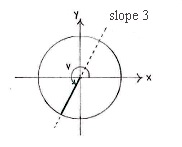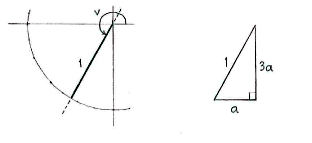Solution 4.3:6c
From Förberedande kurs i matematik 1
m |
|||
| Line 1: | Line 1: | ||
| - | Because the angle | + | Because the angle <math>v</math> satisfies <math>\pi \le v\le 3\pi/2\,</math>, <math>v</math> belongs to the third quadrant in the unit circle. Furthermore, <math>\tan v = 3</math> gives that the line which corresponds to the angle |
| - | <math>v</math> | + | <math>v</math> has slope 3. |
| - | satisfies | + | |
| - | <math>\pi \le v\le | + | |
| - | <math>v</math> | + | |
| - | belongs to the third quadrant in the unit circle. Furthermore, | + | |
| - | <math>\ | + | |
| - | gives that the line which corresponds to the angle | + | |
| - | <math>v</math> | + | |
| - | + | ||
| - | + | ||
| - | has | + | |
| - | + | ||
| - | + | ||
[[Image:4_3_6_c1.gif|center]] | [[Image:4_3_6_c1.gif|center]] | ||
| - | + | In the third quadrant, we can introduce a right-angled triangle in which the hypotenuse is 1 and the sides have a 3:1 ratio. | |
| - | + | ||
| - | + | ||
| - | In the third quadrant, we can introduce a right-angled triangle in which the hypotenuse is | + | |
| - | + | ||
| - | and the sides have a | + | |
| - | + | ||
| - | ratio. | + | |
[[Image:4_3_6_c2.gif|center]] | [[Image:4_3_6_c2.gif|center]] | ||
| - | If we now use | + | If we now use the Pythagorean theorem on the triangle, we see that the horizontal side ''a'' satisfies |
| - | + | ||
| - | satisfies | + | |
| - | + | ||
| - | + | ||
| - | + | ||
| - | + | ||
| - | + | ||
| - | + | ||
| - | + | ||
| - | + | ||
| - | + | ||
| - | + | ||
| - | + | ||
| - | + | ||
| - | + | {{Displayed math||<math>a^2 + (3a)^2 = 1^2</math>}} | |
| - | + | ||
| - | + | ||
| - | + | ||
| - | + | ||
| - | + | ||
| - | <math> | + | |
| - | + | ||
| - | + | ||
| - | <math> | + | which gives us that <math>10a^{2}=1</math> i.e. <math>a = 1/\!\sqrt{10}\,\textrm{.}</math> |
| + | Thus, the angle ''v'''s ''x''-coordinate is <math>-1/\!\sqrt{10}</math> and ''y''-coordinate is <math>-3/\!\sqrt{10}</math>, i.e. | ||
| - | <math>\sin v=-\frac{3}{\sqrt{10}}</math> | + | {{Displayed math||<math>\begin{align} |
| + | \cos v &= -\frac{1}{\sqrt{10}}\,,\\[5pt] | ||
| + | \sin v &= -\frac{3}{\sqrt{10}}\,\textrm{.} | ||
| + | \end{align}</math>}} | ||
Current revision
Because the angle \displaystyle v satisfies \displaystyle \pi \le v\le 3\pi/2\,, \displaystyle v belongs to the third quadrant in the unit circle. Furthermore, \displaystyle \tan v = 3 gives that the line which corresponds to the angle \displaystyle v has slope 3.
In the third quadrant, we can introduce a right-angled triangle in which the hypotenuse is 1 and the sides have a 3:1 ratio.
If we now use the Pythagorean theorem on the triangle, we see that the horizontal side a satisfies
| \displaystyle a^2 + (3a)^2 = 1^2 |
which gives us that \displaystyle 10a^{2}=1 i.e. \displaystyle a = 1/\!\sqrt{10}\,\textrm{.}
Thus, the angle v's x-coordinate is \displaystyle -1/\!\sqrt{10} and y-coordinate is \displaystyle -3/\!\sqrt{10}, i.e.
| \displaystyle \begin{align}
\cos v &= -\frac{1}{\sqrt{10}}\,,\\[5pt] \sin v &= -\frac{3}{\sqrt{10}}\,\textrm{.} \end{align} |


